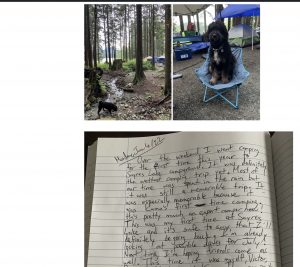Georgia’s Post – Manual Scripts
https://blogs.ubc.ca/gkadawong/2022/06/09/task-4-manual-scripts/

Georgia’s pictures from her post on Manual Scripts
- What web authoring tool have they chosen to manifest their work? Georgia chose to use photo documentation to showcase her work. She wrote everything out by hand and provided photographs of her writing journey. Georgia even provided photos of her main subject, Kuma, to provide context behind her written journal entry of Kuma’s first camping trip. By choosing to write her post by hand, this allowed for a free flow of thoughts to be composed that was authentic. Her writing emitted flow within the words, emotions could be conveyed, and it also allowed the reader to be a part of something personal to connect with the author. I was able to draw similarities and differences within the writing sample to my own. We both crossed out mistakes in our writing sample and admit to not being strict on formal edits when writing freely.
- What literacies compare and deny in comparison and contrast to yours? I would like to focus on the writing tools that Georgia chose to compose her writing sample. I noticed right away, before reading the words, that she used two different coloured pens and a pencil for this task. It made me question why this was the case. As I read her writing, she addresses the reasons for the multiple writing tools for the task as a strategy plan. She discussed that efficiency is the main difference between writing by hand versus mechanized forms of writing. Georgia provided the example of how her original pen failed her and therefore she had to find a substitute. When writing about her camping trip, Georgia chose to write in pen because she was not concerned with providing formal edits and therefore this allowed for a free flow of thoughts without constraints. I also used ink for my writing sample because I felt the exact same way. There is a formality behind a typed out piece of writing, where the expectation is that it will be free of errors. I noticed that she used ink to highlight the questions for her reflections and answered the questions using pencil. The use of different writing tools to differentiate headings vs personal written thoughts, draws attention to the reader’s eyes. Georgia’s choice in using pencil when writing out her reflections allowed her the convenience of making “edits easier and more formally with an eraser.” I chose not to use pencil for this task because I find it physically harder to write with a pencil. You have to push down harder to have the lead transfer onto the paper and the width of the pencil hurts my fingers while writing, especially during long durations or if I’m writing quickly. Thus is the reason I chose to type out my reflections so that the writing appears more formalized and I was able to edit my work using the mechanics of software such as autocorrect spell checking. So I have to agree with Georgia that one of the main differences between writing by hand and mechanized writing is efficiency but I would like to add presentation and formality to the list as well.
- What theoretical underpinnings are evident in your/your colleague’s textual architecture and how does this affect one’s experience of the work? As I was reading Georgia’s post, I observed that she wrote her journal entry into the middle of a notebook which makes it appear that it had been used before. When listening to the creators of the podcast, Stuff to Blow Your Mind, in their episode, “From the Vault: Invention of the Book, Part 1,” they speak of the purpose behind a book. The podcasters provide the argument that “books are fixed memories in documentation” and contain thoughts that are frozen. Books are a way of “storing and disseminating information” and an “extension of the human mind.” Although Georgia’s book is more of a journal, it is personal and it is a way for her to express herself. Journals or diaries are not always meant to be shared with an audience so I wonder how the writing would’ve changed if it was for her eyes only.
Journals are a kind of archaeological evidence, in text form, that represents the evolution of one’s life. The things I wrote about when I was in elementary school versus high school are drastically different. It shows how I have evolved overtime emotionally, socially, and personally. Even the physical shape and type of books I would write in changed over time. The type of diaries I used in elementary school included ones with a cute cover that came with a lock and key. The journals I kept in high school were more in the shape and form of notebooks. I still have these diaries and journals but they are stored deep inside my garage and away from my children to find them. These documented memories are only fixed in writing and not in real life, thank goodness!
References
Georgia. Manual Scripts. https://blogs.ubc.ca/gkadawong/2022/06/09/task-4-manual-scripts/
Stuff To Blow Your Mind, entitled “From the Vault: Invention of the Book”, Part 1.
